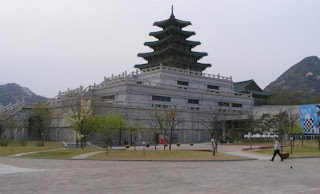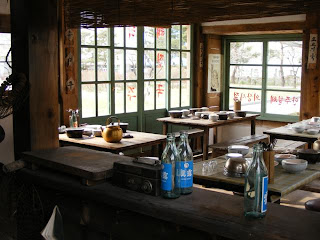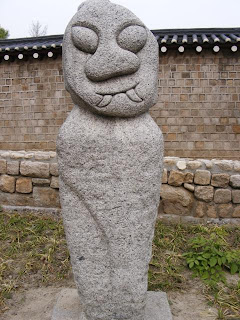The National Folk Museum of Korea may be visited in the complex of the Gyeongbok Palace, in a building very much alike a Japanese castle. Because of lack of time, I decided to visit only the outside exhibition, organised in the form of a traditional village.
So, I saw a traditional house, with an interior little yard, like a patio, and pots with kimchi in the courtyard (a specific Korean side-dish, made of cabbage), a barber’s shop, a pub, some shops like those selling medicinal herbs, sandals and hats. There was also a mill, constructed and used by all the villagers together because it was very expensive.
A special place is occupied by stone statues and objects. Some of them are put at the graveyards of richer villagers, and some are put at the entrance of the village, to protect against evil spirits, illnesses and ghost and to bring prosperity for the village.
Muzeul National de Folclor al Coreei este gazduit intr-una dintre structurile Palatului Gyeongbok, care seamana foarte mult cu un castel japonez.
In fata sa, un fel de fantana – fara apa – care prezinta toate animalele zodiacului chinezesc.
Pentru ca nu mai aveam prea mult timp, am vizitat doar expozitia exterioara a muzeului, aranjata sub forma unui muzeu al satului, mai mic. Si iata ce am vazut expus acolo:
Mai intai, o casa traditionala coreeana. In fata sa se afla un stalp de piatra, “supyo“, cu ajutorul caruia se masura adancimea apei, cu scopul de a fi avertizati de iminenta unei inundatii. Stalpul are pe el niste diviziuni de 20 cm, numite “chock”. Sub 3, era seceta si peste 9 – pericol de inundatie. Prima data au fost folositi acesti stalpi in timpul regelui Sejong, in sec. al XV-lea. Raul Han dadea atunci multe batai de cap locuitorilor capitalei deoarece se revarsa de multe ori.
































Nice places and good photo’s, very well done again.
Greetings, Joop
Ce frumos e iepurasul din zodiacul chinezesc!
Mi-au placut mult toate fotografiile.
Thanks, Joop! Have a great week!
Toate sunt reusite, Liliana. Lumea se fotografiaza cu ele, presupun ca fiecare cu semnul sau
An interesting museum, even if folklore is not really my thing… Funny statues!
Thanks, VP!
tare frumos, asa imi place.. pfuu.. si eu vreau..
Interesting looking museum. Love the architecture.
The sculptures are very interesting. The others will put smiles on your face. Kids will enjoy touring this area too.
Thanks a lot for sharing your photographs, my friend. Visual tour galore and I love it.
smalldot, poate ajungi si tu acolo…
I liked it too, Randy:)
Thank you, Rizalenio, for being here.
Looks like a fascinating museum!
By the way, I’ve just come back from Romania and must say that I’m in love with your country!
Greetings:)
Wow, Joo! You said nothing about coming here! Where have you been and what have you seen?
Thanks for the comment!
the museum looks fabulous and i enjoy the architecture. the sculptures are intriguing. there must be interesting stories behind them.
De cand asteptam articolul acesta! Cred ca a fost ceva in neregula cu blogspot-ul zilele acestea. Mi-a aparut de mai multe ori titlul articolului in lista de “articole recente”, dar nu reuseam sa il accesez.
Imi place foarte mult casa traditionala si butoaiele de kimchi aranjate frumos la soare. Nu prea intelegeam obsesia coreenilor pentru varza murata pana cand nu am gustat-o. E foarte buna si aromata. Acum inteleg de ce majoritatea au in casa un frigider special pentru pastrarea vaselor cu kimchi pe timpul verii.
Scaunele din frizerie, sabotii de lemn, snopii de plante puse la uscat…totul pare incremenit in timp. Multumesc frumos pentru ocazia de a calatori virtual in acest spatiu minunat. Eu sunt indragostita de tot ceea ce inseamna lumea satului si sunt cu atat mai fascinata cu cat satul apartine unei culturi mai indepartate si greu accesibile lumii mele.
@ Life Ramblings: some of them are put near graves, some belong to the phalic cult (praying for a boy to be born, village protection, rich crops etc.), and some are put at the margin of the village or on the roads (the last ones) to protect them from evil spirits.
impressive place. though it’s in korea it’s still oriental making those animal statues remind me of kung fu panda.
VertAnge, eram la munte cand cu postarea, la cabana mea din V. Ariesului si am scris si anul trecut ca am acolo mari probleme cu postatul, cu cititul si commenturile mele la altii. Conexiunea prin Orange ba merge ba nu merge sau e extrem de lenta. Cu postarea asta s-a intamplat ca o doream mai tarziu dar i-am dat, din greseala, “publish” inainte de a fixa data si n-am stiu cum sa anulez asta. Deci, greseala mea:) Sorry…
I’m glad you like it, dong ho!
Very nice traditional photos!!!
Seoul is a very interesting place!!!
Thank you very nuch for the trip!
Many greetings
You are welcome, Magda. I am glad you enjoy my trip.
Nu e nevoie de scuze.Nu am vrut sa suna ca un repros, doar ca am fost nerabdatoare
Am inteles asta!
It is difficult to imagine traditional buildings like this in Korea. Your posts are an education to us. Those sculptures are amazing.
That’s the point, J_on_tour! I wanted to show you places which are less seen by people in Europe. Even if they visit Asia, they choose to go to China, Japan, Thailand,Bali, etc. and seldom to South Korea. I wanted to show you that this country has so much to offer as culture and tourism. Thank you for your comment.
I’m back from my vacatian in the Balkans, and I will start to write again about South Korea (aprox. 5 posts).